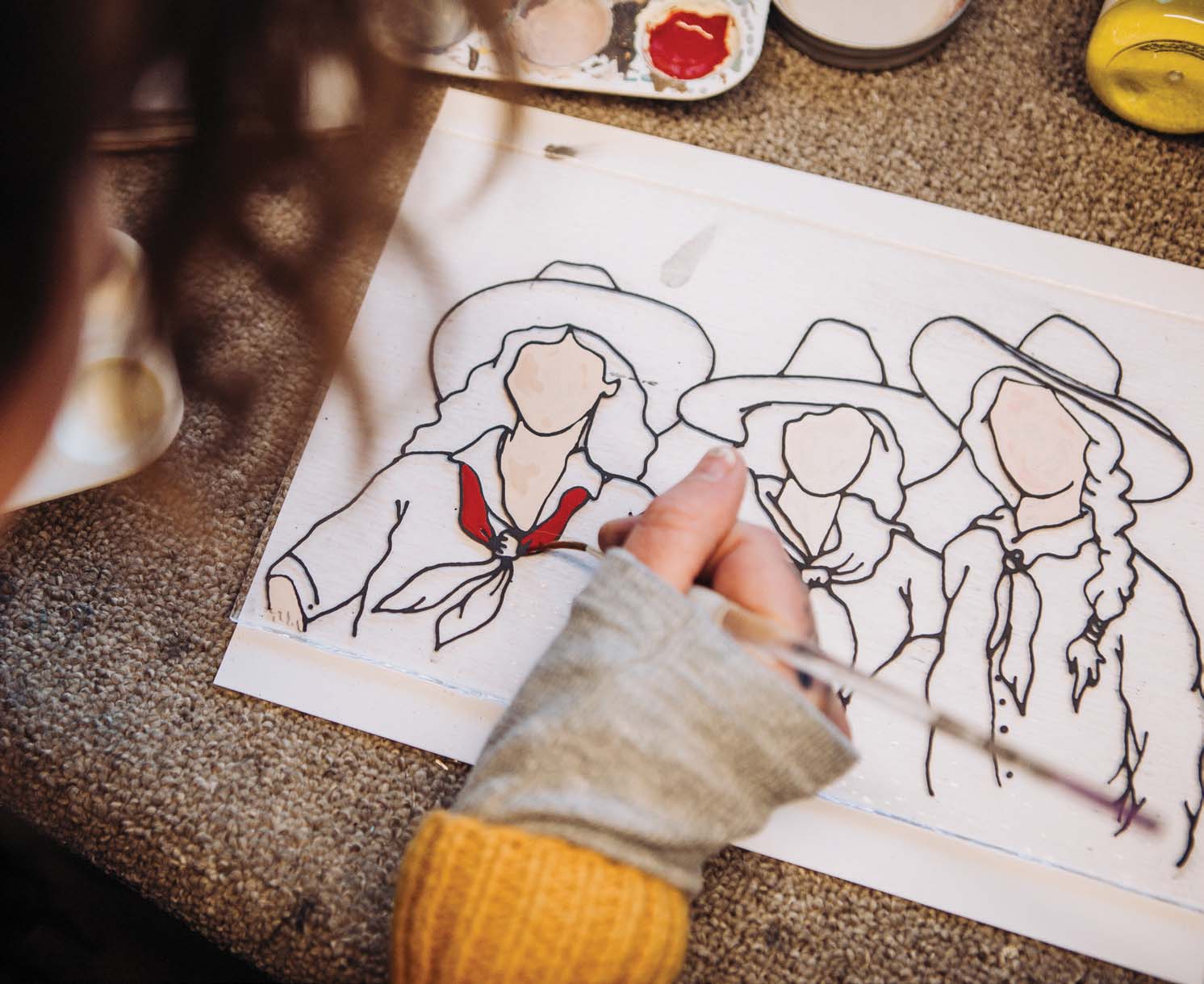
22 Nov ARTIST OF THE WEST: THE HIGH LONESOME
Lois Keister of The High Lonesome is a layered mix of grit and grace. A contemporary Western artist based in Montana’s Ruby Valley town of Sheridan, she creates fine art glassworks for both display and use. But Keister doesn’t just work in glass, she embodies it — delicate material, fired repeatedly under high temperatures, becoming durable artifacts that radiate light and complexity, not unlike the forgotten women of the Old West. Her glass pieces, both intricate and abstract, are rooted in the mythic stories of a time long ago.
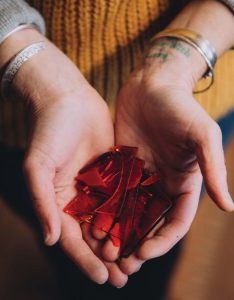
Particularly used for her floral work, Keister’s hand-cut accessory glass creates visual impact and varying color values.
Keister grew up in a tiny town in southwest California on almost 40 acres of desert. A homeschooled kid, she spent her youth exploring the land, riding horses bareback, chasing lizards, and making art. She was endlessly curious, devouring books and discovering old mines, history, and folklore. The desert revealed stories of hardscrabble lives and resilience that Keister deeply respects and reveres.
“Plants, animals, and people — if they are there [in the desert], it’s because they are willing to work really hard,” explains Keister. It was a harsh environment, the ghosts of which would forever set the tone for what inspires her most: a deep longing for something that may or may not have ever existed.
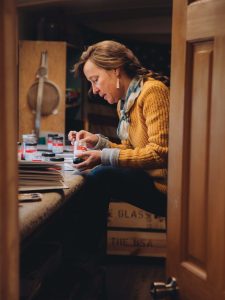
A peek through her studio’s golden door offers a glimpse of Keister in her element.
Keister’s studio is a work of innovation and self-reliance in and of itself. Nestled in the outskirts of town between field and timber, her “tiny studio,” as she calls it, feels almost like a chuckwagon from the pioneer days. Full of her glassmaking essentials and inspirational details, Keister has made do with little, keeping her process clean, streamlined, and authentic. Custom shelves filled with colorful frit, or grains of glass; an eclectic collection of molds, most of which are thrifted or antique; and a powerful kiln that reaches incredibly high temperatures are all Keister needs to fuel her work. Well, that and her golden door. Through a serendipitous moment at an art show whereby she met a jeweler, said a prayer, and acquired a ring, Keister was inspired to paint her studio door gold to signify the discovery of life’s purpose, the path forward toward inner fulfillment.
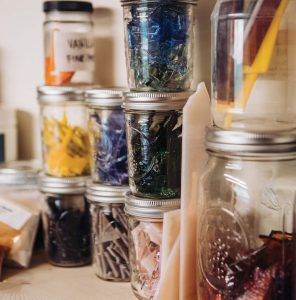
Lois Keister works with a large variety of glass sizes to give a piece texture and physicality, tone and shading, details and visual interest.
Keister is a storyteller, continuing the visual history tradition of the Old West. Endlessly inspired by literature, she revels in stories from the past, diving into libraries and museums with vigor. The no-nonsense writings of Edward Abbey capture her true love for the desert. Maynard Dixon, Georgia O’Keeffe, and Mary-Russell Ferrell Colton, “desert artists,” as Keister refers to them, have greatly influenced her work. She is drawn to their extraordinary use of colors and the simplicity with which they convey the landscape, as well as the value they place on preserving its legacy.
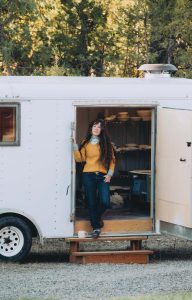
Keister’s tiny studio is an enclosed trailer retrofitted with her high powered kiln, workspace, and materials.
Using authentic historical imagery and symbolism, she curates collections of quiet Western moments in her glass illustrations, capturing a gesture, expression, or emotion. These moments seem to weave a thread from past to present. She shares real facts about pieces and their inspiration with patrons, such as dates and places, giving context and sparking an interest in history. Often leaving faces without detail, Keister invites viewers to place themselves within the story and imagine their own relationships to the piece. Through this window, patrons co-create with Keister, becoming storytellers themselves and leading the narrative forward.
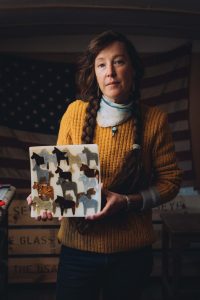
When depicting horses, Keister’s forms recall traditional carved wooden horses from Sweden, known as Dala horses. She incorporates them for their simplicity and symbolic homage to the Swedish settlers of Montana’s Hi-Line. This piece is titled Sunbleached Dalas.
The process of creating kiln-formed glass is incredibly time-consuming. Keister pours over every detail, from finding authentic imagery to skillfully selecting color palettes, working one piece at a time. Each starts as individual layers of glass. She begins by sketching her illustration on a transparent piece, then hand-applies glass enamel, a superfine glass powder. Working only with primary colors, she swiftly and expertly mixes her colors before they dry, creating dreamy interpretations of her subject matter. She then layers in complimentary colors of larger grains of glass to add shading, dimension, and visual texture. She places her pieces in a mold and fires them at high temperatures in the kiln, often over 1,400 degrees Fahrenheit, for 12 to 14 hours. Sometimes, she will go back again with more layers and more firing until the piece is complete. The process of layering and firing creates glowing artwork that feels substantial in your hands.
It didn’t take Keister long to realize she had found her niche in glass. She has dabbled in many mediums, from painting to mixed media, and even has a degree in welding, but just five months after an apprenticeship with renowned glass artist Kathy Burk, she began firing her own pieces. A couple of months later, she was invited to do her first solo show, securing her commitment to continue.
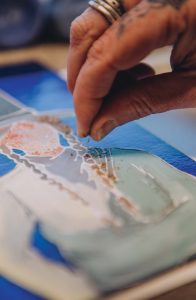
Keister precisely sprinkles frit, or sand-like glass, to add shading to the figure.
Keister has been busy trailblazing glass in Western art ever since. In 2024, she was selected for the Inspired by Yellowstone Artist Series, a program at Yellowstone National Park that showcases a variety of creators struck by the park’s beauty. She is currently represented by Gallery 287 in Ennis and Cassens Fine Art in Hamilton. Michelle Cassens, the curator for the latter, invited Keister to show her first solo exhibition. Keister had worked for the gallery as a lead framer, and as she broke out on her own in glasswork, Cassens was thrilled to showcase her work in the gallery. “I love each and every one of [Keister’s pieces],” remarks Cassens. “And Lois’ path is so true to who she is as a person.”
Keister’s impact on Western art and, more specifically, Western culture might lie in the fact that it is functional. Making food-safe bowls, dishes, and plates, she is passionate about functional art and its role in our lives, both historically and today. At a time when personal belongings were scarce, great care was given to decorating everyday items with intention and beauty, particularly Western ware and tools. From hats to chaps and saddles, artistry was often displayed through beadwork, color palettes, and leatherwork to create a sense of identity and ownership.
Cassens often sees functional art dismissed by the fine art community, particularly kiln-formed glass. Rebuking the notion, she explains, “Glass is a functional medium. In that sense, it integrates Western culture; we use our horse or material things, and we cherish them. But when we look at our society as a whole, with the advent of modernism and our streamlined architecture, spaces become sterile. I see what I call the loss of fine art.” For Keister, building these functional art pieces back into our homes honors Western traditions and values.
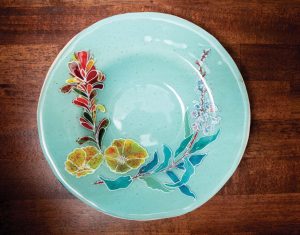
Inspired by the bright shocks of color across the Northern Rockies’ spring and summer landscapes, Keister often uses wildflowers in her work, as with Cow Camp Bouquet, pictured here.
When someone takes home one of Keister’s pieces, they are taking home a bit of the past and a bit of the present, creating an heirloom for the future. By simply integrating these treasures into our daily lives, we imprint our own story onto the piece, building onto it for the next generation. “When oral history fails us, visual history is what we have left,” explains Cassens.
Gallery 287 owner Cathy Toot admires the artist’s process and vision. She says Keister’s work “helps people distill what used to be, remember the things they might have experienced or heard about, like a long-ago memory. It brings back something heartfelt.”
And it’s true. There is an unexpected intimacy that surfaces in Keister’s vignettes, like an intangible, forgotten memory of a time long ago. Maybe that is, in fact, the myth of the West, the reason why its stories, struggles, and wild freedom stir a longing in many of us. Perhaps it’s a longing for something that may or may not have existed at all.
Sara Gilman is a lifestyle and editorial photographer in rural southwest Montana focusing on agriculture, food, and art. A farmer and gardener herself, Gilman tells stories of the land, the people, and their work; saragilmanphoto.com.




No Comments